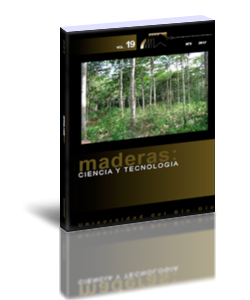Effects of plasma surface treatment on bending strength and modulus of elasticity of beech and poplar plywood
Keywords:
Fagus orientalis, IR spectra, mechanical properties, plasma treatments, Populus deltoides, veneers.Abstract
This is a study on the effect of plasma treatment with different gases and plasma intensity on the bending strength and modulus of elasticity of plywood manufactured from beech and poplar. Oxygen (O2) and ammonia (NH3) plasma were applied on the veneer sheets; two plasma intensities were applied on the veneers with 150 and 300 W in the plasma chamber during one minute. Phenol formaldehyde resin was applied on one surfaces of each veneer with approx. 160 g/m2. Bending strength and modulus of elasticity were determined according to EN 310.The effects of plasma surface treatment on chemical structure of the panels were determined with FTIR-ATR analysis. Bending strength of all tested panels slightly and partly increased without statistical significance when applying oxygen plasma. The effect of ammonia plasma treatment on bending strength and was determined by the wood species and the plasma intensity, and it was not uniform. Modulus of elasticity of the panels with oxygen plasma treatment showed in most cases improvement, whereas ammonia plasma pretreated veneers caused lower values compared to the control panels.Downloads
References
Acda, M.N.; Devera, E.E.; Cabangon, R.J.; Ramos, H.J. 2012. Effects of plasma modification on adhesion properties of wood. Int J Adhes Adhes 32:70-75.
Aydin, I.; Demirkir, C. 2010. Activation of spruce wood surfaces by plasma treatment after long terms of natural surface inactivation. Plasma Chem Plasma P 30:697-706.
Berman, D.; Krim, J. 2012. Impact of oxygen and argon plasma exposure on the roughness of gold film surfaces. Thin Solid Films 520:6201-6206.
Chen, P.; Zhang, C.; Zhang, X.; Wang, B.; Li, W.; Lei, Q. 2008. Effects of oxygen plasma treatment power on surface properties of poly(p-phenylenebenzobisoxazole) fibers. Appl Surf Sci 255(5): 3153-3158.
Demirkir, C.; Aydin, I; Colak, S.; Çolakoğlu, G. 2014. Effects of plasma treatment and sanding process on surface roughness of wood veneers. Turk J Agric For 38(5):663-667.
EN 310. 1993. Determination of Modulus of Elasticity in Bending and of Bending Strength. Fan, L.T.; Ghaipuray, M.M.; Lee,Y.H. 1987. Cellulose Hydrolysis. Springer, ISBN- 13:978-3-642-72577-7, Springer-VerlagBerling Heidelberg, New York.
Fun, T.S.; Jumaat, M.Z. 2013. Comparison Of European Standard EN 310 And EN 789 In Determining The Bending Strength And Modulus Of Elasticity Of Red Seraya (Shorea Spp.) Plywood Panel: Experimental and Finite Element Analysis. Eur J Wood Prod 71:483-490.
Hon, D. N.S.; Shiraishi, N. 2001. Wood and Cellulosic Chemistry. Second Edition, Revised, and Expanded, , ISBN 0-8247-0024-4, Marcel Dekker, USA.
Karahan, A.; Demir, A.; Ozdogan, E.; Oktem, T.; Seventekin, N. 2007. Plasma Technology and Basic Features. International Textile Technology Magazine 127:102-106.
Kim, B.S.; Chun, B.H.; Lee, W.I.; Hwang, B.S. 2009. Effect of Plasma Treatment on the Wood Flour for Wood Flour/PP composites. J Thermoplast Compos Mater 22:21-28.
Lewin, M. 2007. Handbook of fiber chemistry. Third edition, Taylor & Francis Group, LLC, ISBN 9780824725655, USA.
Marra, A.A. 1992. Technology of wood bonding: principles in practice. Van Nost. Reinh., New York.
Mortazavi, M.; Nosonovsky, M. 2012. A model for diffusion-driven hydrophobic recovery in plasma treated polymers. Appl Surf Sci 258:6876-6883.
Podgorski, L.; Chevet, B.; Onic, L.; Merlin, A. 2000. Modification of wood wettability by plasma and corona treatments. Int J Adhes Adhes 20:103-111.
Seki, Y.; Sever, B.; Sarikanat, M.; Gulec, H.A.; Tavman, I.H. 2009. The Influence of Oxygen Plasma Treatment of Jute Fibers on Mechanical Properties of Jute Fiber Reinforced Thermoplastic Composites. 5th International Advanced Technologies Symposium In: 5th international advanced technologies symposium (IATS’09), Karabuk, Turkey.
Unger, A.; Schniewind, A.P.; Unger, W. 2001. Conservation of wood artifacts, a handbook, Springer, ISBN 3-540-41580-7, Springer-VerlagBerling Heidelberg, New York.
Wolkenhauer, A.; Avramidis, G.; Hauswald, E.; Militz, H.; Viöl, W. 2009. Sanding vs. plasma treatment of aged wood: A comparison with respect to surface energy. Int J Adhes Adhes 29:18-22.
Zhou, X.; Zheng, F.; Lv,C.; Tang, L.; Wei,K.; Liu, X.; Du, G.; Yong, Q.; Xue, G.2013. Properties of formaldehyde-free environmentally friendly lignocellulosiccomposites made from poplar fibres and oxygen-plasma-treated enzymatic hydrolysis lignin. Composites: Part B 53:369-375.
































